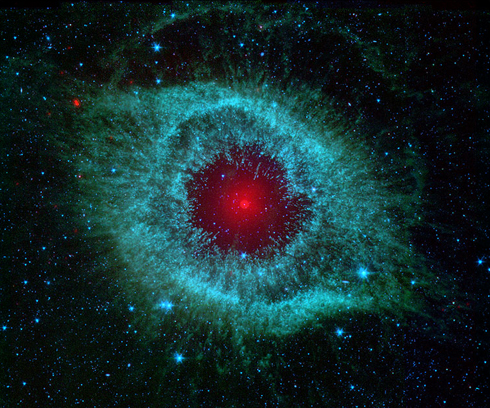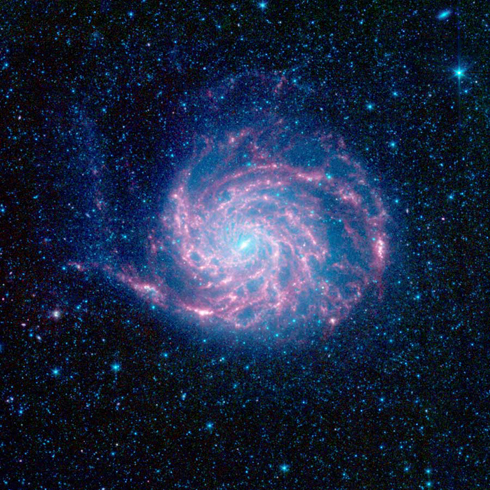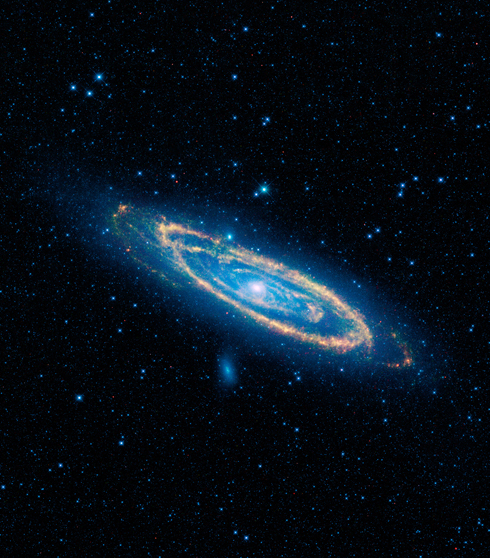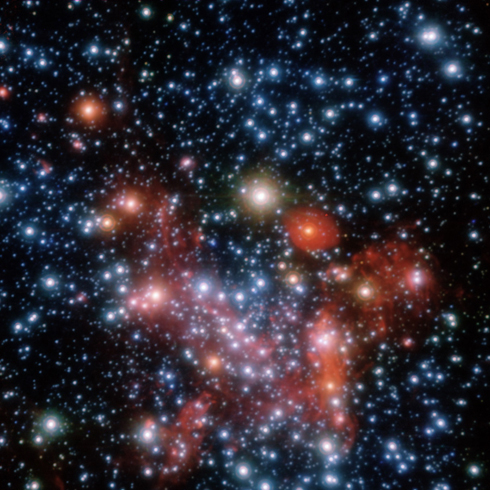Infrared telescopes are vital tools for astronomers. Observing at infrared wavelengths allows them to see through dust and gas, revealing regions of astronomical objects that may be obscured from view at other wavelengths (like ‘visible light’ that you and I can see). Similarly, powerful infrared telescopes are able to reveal the farthest galaxies in the Universe, allowing astronomers to study how the earliest galaxies evolved.
I’ve put together ten of my favourite infrared space images below but what would your top ones be? Have I missed a real cracker? Let me know in the comments below, or drop me a tweet. Clicking on the images will take you to the big versions (and be warned I mean big!) whilst clicking the title of the picture takes you to a news story about the science behind it.
1. Clouds of dust and gas in the Eagle Nebula
One section of the Eagle Nebula was made
famous by the Hubble Space Telescope image dubbed the ‘Pillars of
Creation’. Can you spot the ‘pillars’ glowing in this image from the
Spitzer Infrared Space Telescope?
 NASA/JPL-Caltech/N. Flagey (IAS/SSC) & A. Noriega-Crespo (SSC/Caltech)
NASA/JPL-Caltech/N. Flagey (IAS/SSC) & A. Noriega-Crespo (SSC/Caltech)
2. A stripy Saturn
Infrared radiation reflected off Saturn reveals the Ringed Planet in this view from the Hubble Space Telescope.
 Erich Karkoschka (University of Arizona), and NASA
Erich Karkoschka (University of Arizona), and NASA
3. The magnificent arms of M81
M81, also known as Bode’s Nebula, is a
galaxy in the northern hemisphere constellation of Ursa Major and is a
fine sight in a small telescope. Dust clouds within its spiral arms are
revealed in red in this picture.
 NASA/JPL-Caltech/S. Willner (Harvard-Smithsonian Center for Astrophysics)
NASA/JPL-Caltech/S. Willner (Harvard-Smithsonian Center for Astrophysics)
4. Wisps of gas and dust at our galaxy’s centre
A 900 lightyear diameter region towards
the heart of the Milky Way is shown in spectacular detail in this
panoramic image from Spitzer.
 NASA/JPL-Caltech/S. Stolovy (Spitzer Science Center/ Caltech)
NASA/JPL-Caltech/S. Stolovy (Spitzer Science Center/ Caltech)
5. An eerie eye looks out from the Helix Nebula
It might look like the eye of an angry
monster staring back at us but this is in fact a planetary nebula – a
huge ejected shell (or series of shells) of gas and dust created towards
the end of a Sun-like star’s life.
 NASA/JPL-Caltech/K. Su (Univ. of Ariz.)
NASA/JPL-Caltech/K. Su (Univ. of Ariz.)
6. The sparkling spiral of the Pinwheel Galaxy
The Pinwheel Galaxy lies 27 million
lightyears away from the Earth in the constellation of Ursa Major. Its
beautiful twisting spiral arms shine brightly in this detailed image.
 NASA/JPL-Caltech/STScI
NASA/JPL-Caltech/STScI
7. The swirling Sword of Orion
The Orion Nebula (M42) at the centre of
the Sword of Orion is one of the finest night sky sights through
binoculars or a small telescope. This image from the European Southern
Observatory’s VISTA telescope however reveals regions of the nebula that
amateur astronomers cannot see.
 ESO/J. Emerson/VISTA. Acknowledgment: Cambridge Astronomical Survey Unit
ESO/J. Emerson/VISTA. Acknowledgment: Cambridge Astronomical Survey Unit
8. The Andromeda Galaxy
At a distance of roughly 2.5 million
lightyears away the Andromeda Galaxy is one of the nearest galaxies to
the Milky Way. Young stars in its spiral arms glow yellow in this image
from the WISE telescope, whilst older stars are represented with a blue
hue.
 NASA/JPL-Caltech/UCLA
NASA/JPL-Caltech/UCLA
9. The Milky Way’s heart of stars
Myriad stars sparkle in this image taken
using the European Southern Observatory’s Very Large Telescope. It’s
thought that hidden within this region (the central region of the Milky
Way) is a supermassive black hole.
 ESO
ESO
10. Drifts of dust in the Pleiades star cluster
The Pleiades star cluster is a familiar
sight to amateur astronomers observing the winter night skies. This
image from the Spitzer Infrared Space Telescope shows the vast cirrus
like dust clouds which currently surround the stars of the cluster.

Tidak ada komentar:
Posting Komentar